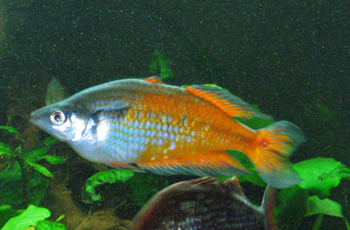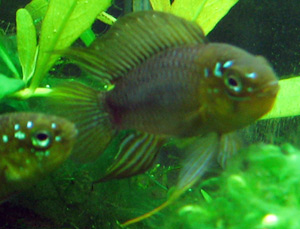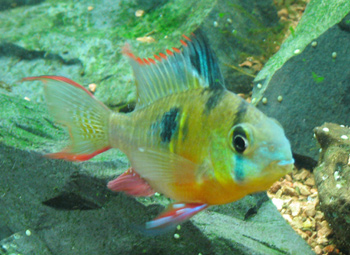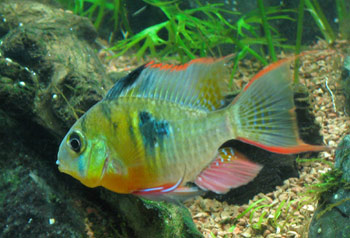October 27th, 2006

I obtained a breeding pair of apistogramma panduro from another apistogramma aficionado in the Capital Cichlid Association, a local cichlid club. These beautiful fish have a 40G breeder tank to themselves, with a few rummynose tetra as dither fish. Shortly after introducing them to the tank, they colored up, and started protecting eggs.
After the eggs hatched, and the fry became free swimming, I fed the fry infusoria, and had plenty of java moss for them to hide from the tetra.

Inevitably, a few of the fry were picked off, but I have a decent number of them left, as adults, now. I’ve kept a few different types of apistos, and I think this particular species is one of the most beautiful ones available. The pictures don’t do this fish justice, but the deep purple body, and iridescent orange fins are incredible. The females look pretty much like most female apistos, except them have the same red border on their tail fin.
They seem to be a relatively peaceful apistogramma species, expressing far less aggression than other apistogrmma to the dither fish, even when spawning. Actually, they seem to spook fairly easily, hiding when I first approach the tank.

Posted in 40G Tank Log, Fish Profiles | 1 Comment »
October 24th, 2006

Melanotaenia parkinsoni might be the most spectacular fish I’ve ever seen in person. Sure, there are some brilliant lake cichlids from Africa and fine looking coral reef fish around the world, but no other fish, as a juenvenille, as stopped me dead in my tracks, dropped jaw and all, in the fish store.
I was in Exotic Aquatics, walking down the aisle, and instantly knew I had to have this fish. As it has grown, the coloration of this fish has only intensified. It is always displaying to the other males in the tank to show its dominance. If you ever have an opportunity to keep this fish, do it.

Posted in Fish Profiles | 1 Comment »
October 23rd, 2006
I bought this glossolepis incisus as a very small, young fish. As you can see, the Red Rainbow has a number of silver flecks on it’s body. When I bought this fish, its entire body was silver, and its body shape was nowhere near as rounded as it is now. It basically looked like an odd shape minnow. Well, as you can see in this bad picture, the fish is still odd shaped, but now much more brilliant than a normal minnow.
This is the only rainbowfish I have in the glossolepis genus. My other rainbowfish are all melanotaenia, nevertheless, this fish has no trouble displaying and competing with the melanotaenia males to become the dominant fish in the tank. It’s really quite a spectacular thing to watch.

Posted in Fish Profiles | 2 Comments »
October 21st, 2006
Melanotaenia splendida australis is a beautiful, but fairly common, rainbowfish. I think this was the cheapest rainbowfish that I have in my 54G, rainbowfish, tank. I believe I paid $1.99 for the juenvenille, drab-looking, fish. Despite it’s youthful appearance, as an adult, I think it might be the most prolific fish, both in spirit and color, that I own. I’d recommend to anyone who wants to try rainbowfish.

I was fortunate to catch it displaying to another male rainbowfish in the tank (below). These fish truly are a marvel to watch, especially in the morning, when they’re especially spirited.

Posted in 54G Tank Log, Fish Profiles | Comments Off on Melanotaenia Splendida Australis
October 8th, 2006
 Even though the tank itself has been in pretty poor shape lately, my male apistogramma borellii have been showing really great coloration lately. Perhaps it’s because I have two want-to-be-dominant males in the same tank, with enough females for them to show off to.
Even though the tank itself has been in pretty poor shape lately, my male apistogramma borellii have been showing really great coloration lately. Perhaps it’s because I have two want-to-be-dominant males in the same tank, with enough females for them to show off to.
It’s been a pleasure to watch them. I have no doubt that with their colors, there are probably some babies somewhere. I haven’t seen any little swarms, but that doesn’t mean they’re not there.
Posted in Fish Profiles | 2 Comments »
September 8th, 2006

Below are some pictures of one the male bolivian rams, microgeophagus altispinosa, that I have in my 75G tank. Unfortunately, I haven’t been able to find any female rams to try breeding this fish. The local fish stores, generally only carry males because their coloration is much more profound than their female counterparts.
Rams are very nice additions to your tank, even in community tanks. Unlike some of their more aggressive cichlid cousins, these dwarf cichlids from South America are quite docile. I have found that when multiple males are put in the same tank, a hierarchy is definitely established, where the dominant male is the largest and most colorful.

I have kept both rams and apistogramma in the same tank without problem. They will not interbreed, and so long as the tank is large enough, the two will not bother each other. The obvious exception is when either is spawning. Recently, my apistogramma cacatuoides began rearing fry, and seem to purposefully pick out the bolivian rams to chase away from their “nest”. They tend to leave various other rasaboras and tetras much more leeway than they do their dwarf-cichlid-counterparts.
Posted in 75G Tank Log, Fish Profiles | 1 Comment »








 Even though the tank itself has been in pretty poor shape lately, my male
Even though the tank itself has been in pretty poor shape lately, my male 
